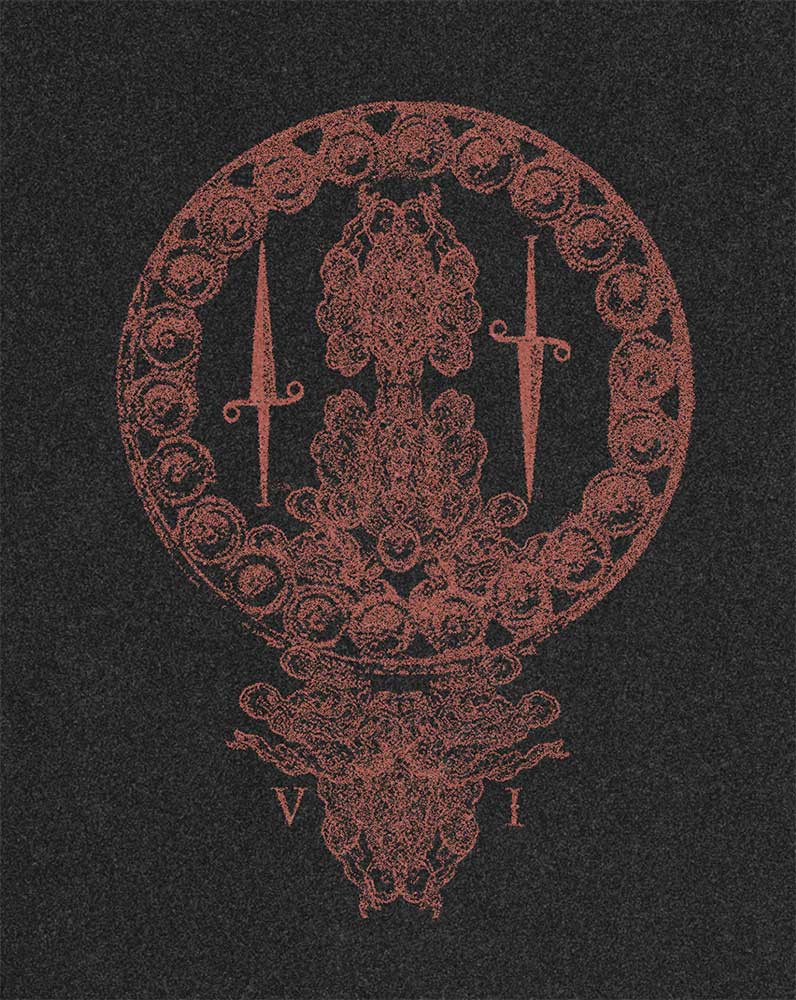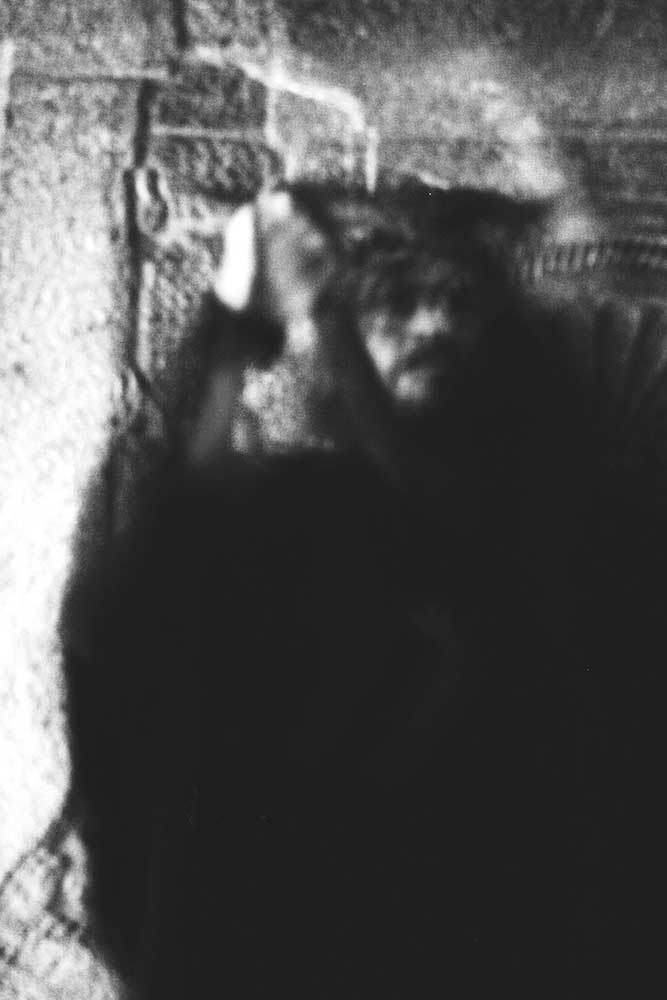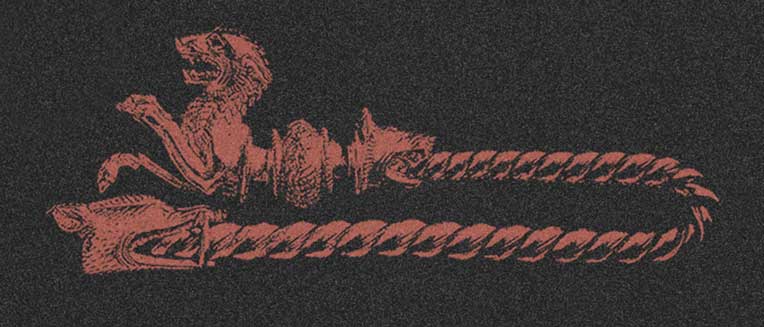Monte Penumbra
2021-03-17
by Niklas Göransson
Anointing the dead beneath the mountains of madness – a discussion about bitter harvests and heightened cognition with long-time scene veteran W.uR of Portuguese black metal band Monte Penumbra.
– The album began taking form in 2016, but I suddenly found myself without a drummer again. If it hadn’t been for Bjarni Einarsson, this album probably wouldn’t exist. When he recorded the drums in June 2018, there was only one guitar track finished. The remaining elements were all composed and recorded afterwards, one at a time, in different sessions. I don’t follow any schedules and would never let mundane matters interfere with this manifestation, so some intervals are bound to happen. Add to that the artwork, studio production, and so forth; it just naturally summed up to that length of time. I try not to make too much of it because there are other, far more crucial, factors.
“As Blades in the Firmament” will be released on March 26, 2021, courtesy of End All Life Productions and Oration. The project must have made a strong impression indeed, seeing as how Stephen Lockhart – owner and operator of Oration as well as Iceland’s Studio Emissary, where the drums were recorded – is very picky about what he releases. Not to mention that this is the first new music issued by French label End All Life since 2018.
– This was a natural continuation of my cooperation with Stephen and his Studio Emissary, whose work the Oration label aims to showcase. He played a central role, having taken the first step towards this co-release and brought the parties together. Stephen also mixed and mastered the album. As for End All Life, I feel any statement would be almost superfluous. I don’t believe there are any serious black metal devotees who are not cognisant of EAL and its continuation, Norma Evangelium Diaboli: true beacons of artistic refinement in a movement under constant threat of vulgarisation. The choice of label is obviously of great significance to a band, as I’m sure many can relate. Once an album has been recorded and then released, you are no longer in control over your work – at least not as you were during its creation. So, when the time comes, it’s like giving your first-born up for adoption. Jokes aside, both band and label must be fully aligned, see the release in the same light, and speak as one voice. In this particular case, there was an unwavering determination from all sides to do so. To illustrate my point, I can tell you that “As Blades in the Firmament” wasn’t even submitted to any other label; such was the resolution.
It could be argued that, historically, certain labels have been just as crucial as the actual bands in terms of driving new developments within the core black metal underground – in both a curatorial and organisational sense.
– Some labels were indeed paramount in their vision, selection, and endowment of this otherworldly aura, facilitating paragon recordings that were in themselves true works of art. By doing so, they serve as entities capable of going beyond the individual bands on their rosters. As I’m often prone to say, in bygone days you would not only be into this or that band – you were into specific labels. However, only a select few manage to attain that level nowadays. As a matter of fact, I recently went through a collection of old flyers and revisited some absolutely outstanding gems. Of course, this is merely an example; nevertheless, it is pretty striking how much the essence has withered since then. ‘A classic case of nostalgia attack’, some might say. Perhaps so, but I’d urge them to compare one of those flyers to a present-day sponsored add on social media. Should they somehow fail to see the difference… to start with, and irrespective of content, it is crystal clear that while the former primarily showcases artistic expressions, the current approach basically relies on mainstream commercial principles. One could then assert that most labels are just trying to widen their audiences in order to survive, even if that means blending different movements. That might be a valid argument to some, yet there’s this saying I find applicable here: ‘Too many candles will burn down the temple.’

Glancing through the booklet, I found it to have a stern and sombre atmosphere that goes well with the album’s sound. I also read the lyrics but found most of them to be somewhat vague – or at least difficult to decipher, armed only with my limited understanding.
– This has been a common trait ever since the first MONTE PENUMBRA release. Partly because my writings, regardless of theme, are genuine attempts at literature. Therefore, the use of literary devices is completely unrestrained. And just like I’d rather not describe one of my songs with something like, ‘Oh, here comes a chromatic power chord sequence with the Phrygian scale variation on bass, accompanied by a triplet bomb blast’, I’d be equally hesitant to dissect its lyrics. My hopes are that the reader will be able to connect on a more subconscious and personal level. Either way, and I could be wrong, but I feel that one can detect a red thread – or at least get the gist of it – by reading the titles as a whole. The album declares life to be beyond mending: a paean to the ultimate unveiling of negative forces, injurious to modern morals. Each title represents a reinterpretation of the first six trumpets from the Book of Revelation, leaving the seventh to be sounded as their Kingdom becomes mere dirt in which they squeal. Moreover, the title “As Blades in the Firmament” is meant as a metaphor for the assault on everything subordinate and holy. Sonically, it should embody both the silent flight of an owl as well as a roaring Jericho trumpet. Either way, it heralds the same outcome: ‘misfortune’, it says.
The first song is called “Black Mould on Rye Grass” – one of the rare allusions I was able to figure out. This is a reference to ergot, a parasitical fungus known to infect crops after floods or intense periods of rain. Eating bread baked from contaminated grains can result in ergot poisoning; known also as St. Anthony’s Fire, this is a nasty affliction which can induce a variety of disorders. From physical illness such as paralysis, burning sensations, convulsions, and tremors to ailments of the mind – mania, confusion, and vivid hallucinations. Many researchers have attributed historical occurrences of supposed mass-hysteria, such as the Salem witch trials, to rye tainted by ergot. Using a water extraction, the fungus’ visionary alkaloids can be separated from the toxins to induce powerful psychedelic effects without any undesirable poisoning. It is likely that such an infusion was the main ingredient in the kykeon, a legendary psychoactive brew used for the Eleusinian Mysteries in Ancient Greece. Ergot is also what Swiss chemist Albert Hoffman famously used to first synthesise LSD in 1938.
– Yes, the opening track was to a certain extent influenced by St. Anthony’s Fire, as well as some artistic depictions thereof by Hieronymous Bosch and Matthias Grünewald. The way I see it, this should partly be interpreted as a quintessential mocking of the Christian faith and subsequent hopes of reaching Heaven. The fact alone that, of all its implications, it was the ‘divine gift’ which served as a gateway to one the most horrific renderings of Hell on Earth in history… damnation in the form of hallucinations and convulsions through what’s supposedly the very symbol of growth and prosperity: crops. Furthermore, the coexistence of natural disasters and ergot poisoning – which has been deeply linked to demonic possession – was probably the source of the so-called ‘dancing plague’, bringing forth another notable preternatural spectacle all over central Europe.
Dancing plague, also known as choreomania, was a mysterious social phenomenon that ravaged mainland Europe for an entire millennium. First reported in the 7th century, it reached its peak during the middle ages but then disappeared abruptly halfway through the 1600s. The condition is well-documented all throughout its history, so there is no dispute that it existed. However, neither historians nor medical scholars have been able to reach any kind of consensus about its nature or causation. Mostly thought to have been some kind of collective mental disorder, groups of people would begin dancing manically for hours on end, often through broken ribs and other injuries, until they either collapsed from exhaustion or were physically subdued. It was known to affect men, women, and children. Besides rhythmic movement, symptoms have been repeatedly reported as irrational mental states involving laughing, crying, and screaming. Some participants would disrobe and add a sexual element to the dance. Oddly, there are also multiple reports of hostile reactions towards the colour red. The first well-documented major outbreak was in Aachen – a city in current-day Germany, home of Ván Records – in 1374. Villagers began pouring out of their homes, cavorting about frantically in the streets until they could no longer move. The dancing plague then spread further across the region, into both Belgium and the Netherlands, affecting thousands of people. Another notable flare-up took place in 1518: in Alsace, nowadays France. Several official sources confirm that a lone woman started dancing by herself but was gradually joined by passers-by. Up to four-hundred persons are believed to have danced for days, despite the authorities’ attempts to intervene. As with all other confirmed cases, no one can say for sure what caused it but many researchers have suggested ergot poisoning.
– However, as it is often the case, that motif is but a part of the whole synecdoche; the entire scope of the lyric delves into the undermining of pillars bearing up mortal existence, thus signifying the initial step towards the album’s central theme. With that being said, all the references you mentioned are far from preposterous, in the sense that they work on relatively similar principles – they too thrust the barriers of the terrestrial and sight beyond the veil of the living.

I often find it interesting to hear people who are from roughly the same generation as I am talk about the local metal scene they grew up in. Before the underground turned digital, things were far more insulated; many scenes had unique characteristics in both music style and ideology. I haven’t met all that many Portuguese over the years, so – besides MOONSPELL and a few others – I don’t know very much about its 90s black metal scene.
– I was born in the north-central part of the country and grew up in a rural environment. Other than brief glimpses, I’m afraid I couldn’t tell you much about the Portuguese scene because I was never really part of it. Throughout my teenage years, the only ‘concerts’ I could attend took place in the woods and hills surrounding the village. A portable cassette player – mostly destined for Norwegian black metal – sometimes an acoustic guitar, and an ever-present large fire… if you ask me, an ideal setting to absorb this kind of music and leave yourself open to mysticism. Anyway, that’s what the ‘scene’ was like in my neck of the backwoods. The lack of means and opportunities left no other alternatives; consequently, the hordes of shiny boots and plastic beer cups of open-air fests were nothing but a distant reality.
Due to family ties, the German language and culture were prominent parts of W.uR’s upbringing. In 2002, a few years after coming of age, he moved to Bavaria by himself.
– During my first year or so, I was ‘on hold’ regarding music in general but, eventually, MONTE PENUMBRA emerged somewhere along the way. This was probably around the time I lived near the Franconian Switzerland – not to be mistaken for the actual country – which might have triggered something creatively. This wasn’t a pre-planned endeavour; it just suddenly dawned on me that I had material which would never be submitted to any of the bands I worked with back then. Besides demanding an approach of its own, it became my steadfast will to traverse its substance. But calling MONTE PENUMBRA a ‘band’ in those days would be an overstatement, since it started purely as a solo project. There were several failed try-outs with different drummers throughout the years, which prevented everything from evolving, and the project eventually stagnated for quite a while. So, its early existence boiled down to lyrics, riffs, samples, and a few song arrangements.
Was the live situation better in rural Bavaria?
– No. It wasn’t until December 2005 I experienced an actual black metal concert – and that was in the Netherlands. It was simultaneously the first time I ever played live, as second guitarist for ISRATHOUM when they opened for HELHEIM. ISRATHOUM was formed in Portugal under a different moniker back in ’92. I joined at some point in the mid-90s, when I was about fifteen years old, but had to pause my participation when they moved to the Netherlands. This concert marks the beginning of my return to the band. I flew over the day before, had but one rehearsal, and inevitably jumped in at the deep end. Needless to say, this entire episode was rather overwhelming in both a positive and negative sense. I then started travelling to Holland approximately once per month to work with ISRATHOUM. All those hours on trains eventually became too time-consuming, so I decided to move there in 2008 and stayed for a few years. I played live on several occasions in different countries, but none of them was ever anywhere near Iberian soil.

Time and resources change everything, leaving W.uR a resident of Portugal since 2011. After almost a decade’s absence, he didn’t have all that many domestic contacts left.
– There was certainly a blank gap on every level. Many years had passed, so – particularly in a relatively small country, where everybody seems to know each other – I ended up being somewhat alien to all that. However, upon my return I simultaneously joined AB IMO PECTORE, a project of a like-minded old friend which was taking its first steps back then, and that was definitely the focus point. I remember it as a period of intense rehearsing and introspection. Actually, it was from the very same alliance that MONTE PENUMBRA’s first line-up eventually emerged. Over time, I became more acquainted with the milieu and some years later I started collaborating with ANGRENOST: another local act with origins dating back to the mid-90s. By now, I can say I am much more aware of the lay of the land but, other than that, there’s not much to add from my side. There are certainly quite a few acts that really impress me; most of which I got to know through the individual behind Altare Productions, who co-released the 2016 MONTE PENUMBRA EP, “The Black Realm Vigil”.
One would hope there were more shows on when you returned?
– I have indeed attended a few concerts in the north, mostly in and around the city of Porto. I get the impression that the audience is increasingly comprised of people from a wide variety of backgrounds – perhaps an indication of how hyped this music has become, or at least for that type of event – and everyone seems to just mind their own business. However, in smaller surroundings people are far more untamed, and you could definitely note a tendency towards the extreme and profane. So, you shouldn’t be too surprised to see some good old fist-pumping action, excessive behaviours, vandalism, and various other illegal activities. This is actually a much more familiar outlook from what I remember as a juvenile and surely matched the opinion of commonfolk.
Two years after moving home again, the debut album of MONTE PENUMBRA, “Heirloom of Sullen Fall”, was released by Daemon Worship Productions. And since then, even though W.uR is still a member of the aforementioned three bands – ISRATHOUM, AB IMO PECTORE, and ANGRENOST – it has been his main project.
– To me, MONTE PENUMBRA has always been a symbolic representation of ‘higher’ cognition. Contextually, and according to my standards, that was its compositional and thematic impetus. In a genre priding itself on being more than just music, striving for the insurmountable is implicit on every plane. You should bite the hand that feeds you and oppose herd mentality, no matter what. And just like ‘the snake which cannot cast its skin must die’, so does each release embrace its own paradigm – channel its destructive force and I will make sure there’s no other way.
‘Monte’ is Portuguese for ‘mount’, whereas the penumbra is the transition point where light meets darkness – such as in a solar eclipse.
– Drawing from anthropology to ascertain the location of primeval death cults or ritual sites, as well as taking archaeoastronomy into account, elevations definitely seem to be a common denominator. Besides hinting at the very cradle of human mysticism, there’s a little-known archaic occult component to it. Shrouded in lore, it’s been pertinent to transcendental iconography: an utterly innate aspect of our species. Take for example the Brocken summit, described in works like Goethe’s Faust as a gathering point for ‘Teufelskulte’, or devil worshippers. The Praxis Magica Faustiana contains an illustration of Mephistopheles which I consider an admirable representation of magical philosophy. His presence is implied by abstract lines of power, or force, which to me bear resemblance to those of a mountain emerging from the depths. Mephistopheles himself remains invisible; he shuns and flees the light and can therefore never be seen. He stands for the light-opposing counterpart, the terrifying Other lurking within the penumbra. Baleful towards one’s individuated self in the averse process of crossing the abyss – the lifeblood of this artistic vein.



